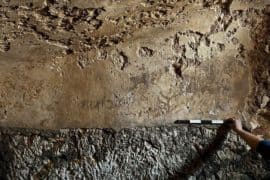How did it happen that the way Jesus came into the world, and how he left—Christmas and Easter—came to define Christianity itself?

I have spent my forty-year career as a scholar of Christian Origins investigating the silence between two back-to-back statements of the Apostles’ Creed, namely that Jesus was: “Conceived by the Holy Ghost, Born of the Virgin Mary,”and that he “Was crucified, dead and buried, and on the third day He rose again from the dead.” [1]Some phrases of this confession of faith appear as early as Ignatius, an early second century Christian bishop (Ignatius, Trallians9). Versions of the full “Apostles Creed” are found in the late … Continue reading
Is it not striking that this oldest and most foundational Christian creed jumps from Jesus’ birth to his death and resurrection, entirely skipping over his life?
How did it happen that the way Jesus came into the world, and how he left—Christmas and Easter—came to define Christianity itself? Here Catholics, mainstream Protestants, and Evangelicals all agree. To be a Christian is to believe in the virgin birth and resurrection of Christ, and thus to participate in the salvation Christ brought to the world as God-in-the-flesh. Where did this emphasis on the “entrance” and “exit” points of Jesus’ heavenly existence come from, and how did it achieve such centrality—even above that of Jesus’ life and teachings?
In 2012 I published my book titled My Paul and Jesus. It continues to seem steadily after seven years! Paul and Jesus is a historical investigation of the origins of this particular way of defining and understanding Christianity. As we shall see, such an understanding of the Christian faith, confessed by millions each week in church services all over the world, originates from the experiences and ideas of one man—Saul of Tarsus, better known as the apostle Paul—notfrom Jesus himself, or from Peter, John, or James, or any of the original apostles that Jesus chose in his lifetime. And further, I maintain that there was a version of “Christianity before Paul,” affirmed by both Jesus and his original followers, with tenets and affirmations quite opposite to these of Paul. This is the lost and forgotten Christianity of James, the brother of Jesus, leader of the movement following Jesus’ death, as well as Peter and all the apostles. In other words, the message of Paul, that created Christianity as we know it, and the message of the historical Jesus and his earliest followers, were sharply opposed to one another with little in common beyond the name “Jesus” itself. Discovering how such a state of affairs came about has been the quest, as well as the adventure, of my life.
I began my first serious encounter with the apostle Paul over forty-five years ago as a college student. I took a Greek reading course called “The Letters of Paul.” [2]My Greek professor was the late Dr. Paul Southern, who had learned his Greek from the incomparable and legendary A. T. Robertson. We were required to translate the original Greek text aloud without … Continue reading That course introduced me to Paul and his world in such a profound way that I was never the same. Day-by-day, phrase-by-phrase, we read through Paul’s writings in the original Greek in a small seminar setting. We discussed every aspect of Paul’s letters, their ideas, and their background. I became “hooked for life” on Paul and that college course marked the beginning of my life-long spiritual and intellectual quest to understand Paul and his place in the formation of Christianity. Like Jacob wrestling the angel at the river Jabbok, I lay hold on Paul and swore that I would not let go until I understood his complex ideas and probed his mysterious depths. In this book I share with my readers what I have discovered over the past forty-five years.
Over the span of my academic career I have taught a course simply titled “Paul”—and I half-jokingly tell the students the first day that Paul is one of those people for whom a last name is not necessary, much like Elvis or Madonna. From my perspective, my class on Paul is the best of a half dozen I regularly teach. I am sure the course is quite different today from my first attempt, but each time I have begun the course I have introduced it with what I intend to be a startling assertion: Paul is the most influential person in human history, and realize it or not, he has shaped practically all we think about everything. I have in mind, of course, the West in particular, but since Christian culture has had such a global spread in our time I think my somewhat extravagant language about “human history” can be justified. As we will see in this book, the foundations of Western civilization—from our assumptions about reality to our societal and personal ethics—rest in a most singular way upon the heavenly visions and apparitions of a single man—the apostle Paul. We are all cultural heirs of Paul, with the well-established doctrines and traditions of mainstream Christianity so deeply entrenched in our culture. In contrast, Jesus as a historical figure, that is a Jewish Messiah of his own time who sought to see the kingdom of God established on earth, has been largely lost to our culture. [3]In my previous book on the life and teachings of Jesus titled The Jesus Dynasty I explore the possibilities of recovering the forgotten message of Jesus
I believe many of my readers have been on their own lifelong quest to understand the historical Jesus, the history and origins of Christianity, and how things shifted from an emphasis on the human figure of Jesus to a heavenly Savior God. Paul and Jesus offers a readable but thorough analysis of the process and the critical role that the Apostle Paul played in the creation of the new religion of Christianity. It is now only $15.29 on Amazon for a quality paperback and it is available in all standard e-Book formats and on CD Audio. If you have not yet, give it a read. Let me know what you think at jamestabor@me.com.









Comments are closed.